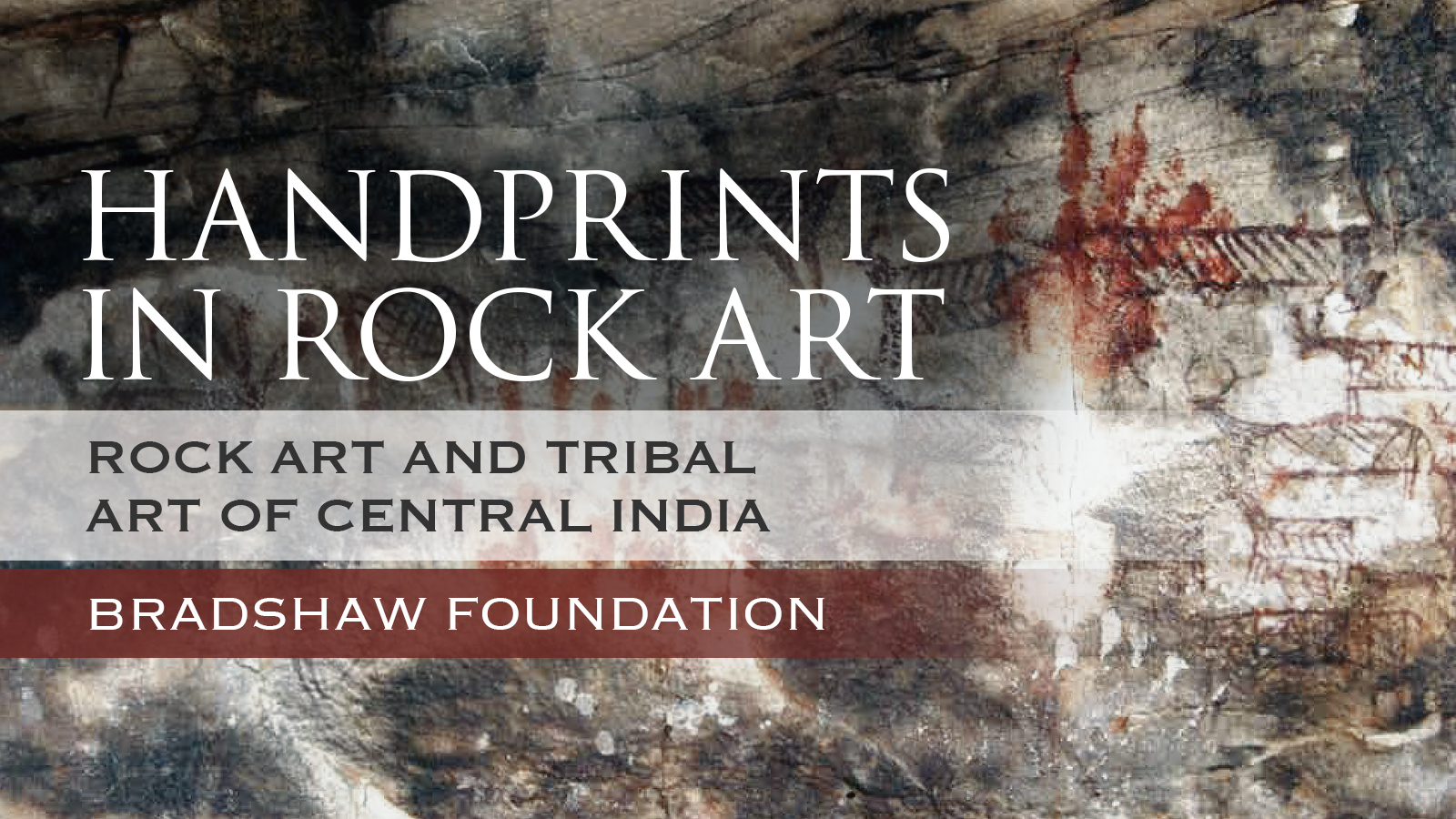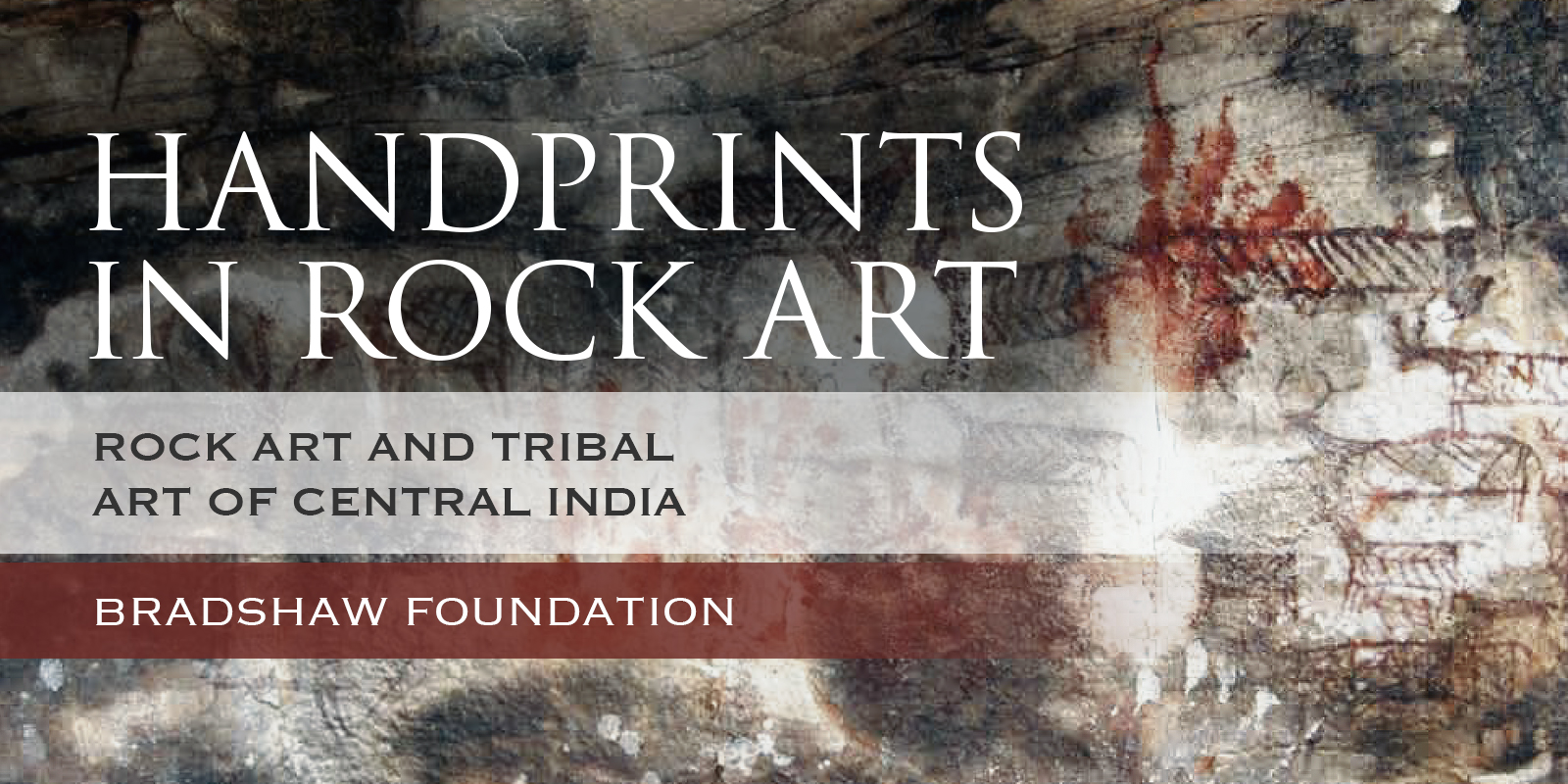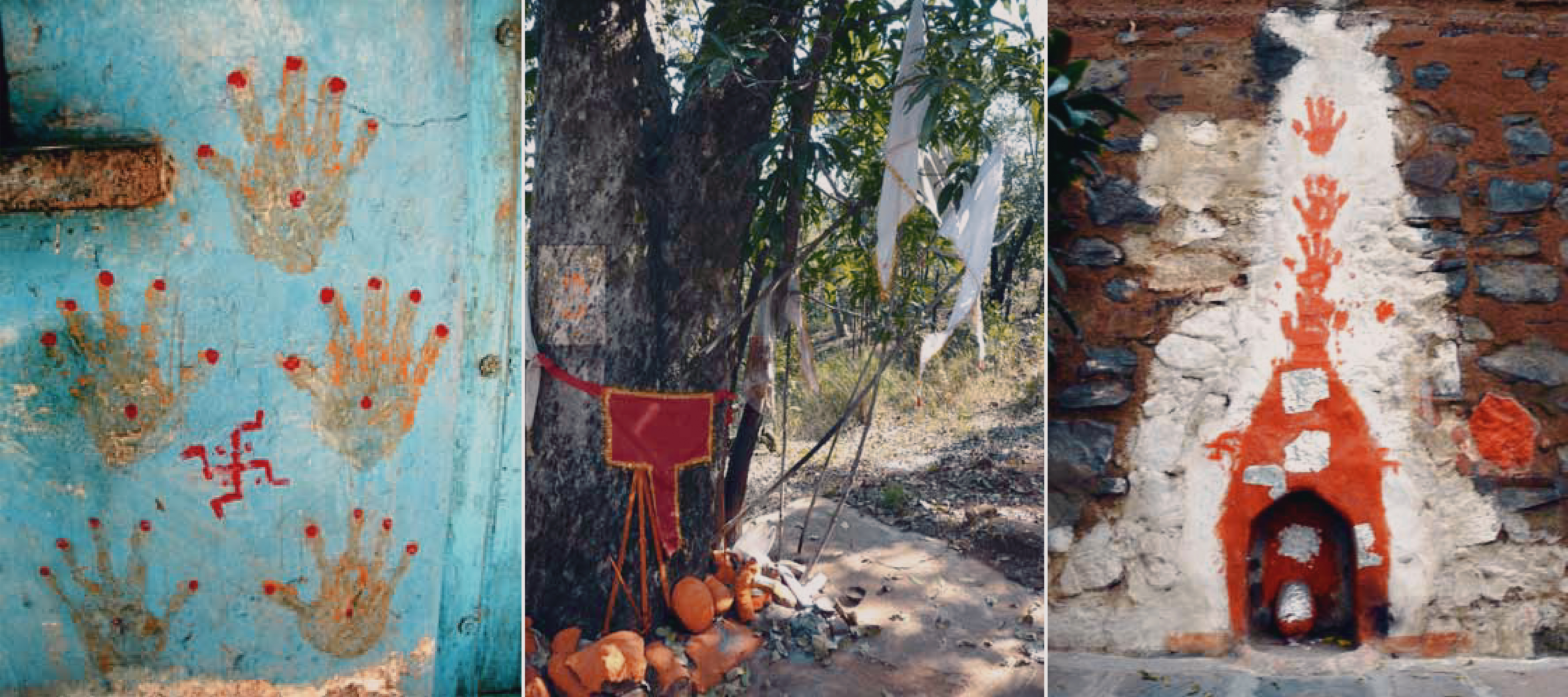


By Meenakshi Dubey-Pathak | Jean Clottes
Red, white and more rarely yellow handprints are a particular motif of Central Indian rock art that we have found in several painted sites, even if it is (not by far) one of the most frequent themes represented. We shall concentrate on the State of Madhya Pradesh where we could study it in different areas.
If handprints are common the world over, in India, and particularly in the region under study, age-old traditions of handprint making are still alive in many places. In certain parts of the State, auspicious handprints are made on both sides of the door or on grain vats, or again on cows or on trees. More to the point, we have collected evidence of handprint making in very recent times -the past decades- in rock art sites of the Rewa and Bhopal regions.
We have systematically looked for information in the local tribes and from local people about the reasons why they made that particular gesture, on what occasions and on who did it, both concerning the rock art and the prints on houses, vats or animals.
We are fully aware that “to read contemporary ethnographic rituals into ancient art may not be quite appropriate in spite of some common traits” (Chakravarty & Bednarik 1997: 87). Thus, we are certainly not advocating “explaining” the rock art and its complex details in the light of present-day practices. The long persistence of ancient traditions in Central India, however, as well as the continuance of ritual practices in painted shelters, including handprinting, enable us to better understand some of the reasons that may have prompted the authors of handprints in the rock art of the region under study.
Handprints made on the occasion of the official beginning of the work for the Chauvet Cave Replica on 12 October 2012.
If that particular Palaeolithic tradition in Europe died out many millennia ago, it was strangely renewed on 12 October 2012, with the start of the work on the Chauvet Cave Replica (Espace de Restitution) at Vallon-Pont-d’Arc, Ardèche, France). Traditionally, for the beginning of an ambitious construction of the kind, an official ceremony is organized. It is called La Pose de la Première Pierre (the laying out of the first stone). In this case it was called La Pose de la Première Main (the laying out of the first hand)... The French Minister of Culture, the Presidents of the Rhône-Alpes Region and of the Ardèche Département, the Mayor and the President of the Scientific Committee for the project were invited to solemnly print their hands on a slab in front of a wide audience, thus launching its completion (Figure 1).
Modern handprints of the village inhabitants in an Australian aboriginal school (Kendall High School).
Not surprisingly, the tradition –which probably is still going on in some places for the rock art- is occasionally revived under other forms, as in an aboriginal school (Kendall High School) not far from Sidney where, some years ago, all the kids and their families printed their hands and names on the walls (Figure 2), while a few friendly visitors were invited to do so on doors.
In India, however, the tradition of handprinting on various supports has never stopped and it is still very much alive. We shall concentrate here on Central India where we are working and where we found examples of handprints not only in very recent rock art but also on both sides of doors, on grain vats, on cows or on trees, not to mention temples, and where we could collect direct information about this ongoing cultural practice.
White handprint recently found in the unpublished Jaldafy site of the Pachmarhi area (Madhya Pradesh).
As to handprints, their most intense concentration is to be found in the Bhimbetka shelters where they have been registered, studied and published by Yashodar Mathpal in his seminal book on the site (Mathpal 1984). He numbered 222 handprints in addition to 16 fistprints and 510 finger dots. We shall keep to the handprints. Those at Bhimbetka are mostly made in various shades of red (155), the others being white (67). 165 are right hands and 57 left. Adults made most of them (207), but nine belonged to children and six to infants (op. cit.: 160-161).
During our recent field work in Pachmarhi we only found one white handprint in the so far unknown site of Jaldafy. It is a small right hand, associated to Late Historic white figures (Figure 3).
One red adult handprint is also visible, even if not very well preserved, among many other figures in Shelter B20 of the huge Chaturbushnath Nalla site. In Shelter B4 of the same site, about eight very faint red handprints came partially out when Dstretched (_lre) (Figure 4). They all seem to be right hands.
In one of the numerous sites of the Penganwa Village (Site 3), at about 75 kilometres east of Bhopal, we saw two small red prints of right hands (Figure 4), so far unrecorded either. After DStretching (_lre), the one to the right appears to have been made in several tries and applications of the hand and not at one go (Figure 5). Another red small hand, in Site 6, was clearer. It was a left hand.
In the Kamur Range of the Rewa area at Deur Kuthar and in the Dharkundi area a number of red and yellow handprints have recently been discovered (Figures 6, 7, 8). Those at Deuer Kuthar were yellow (7) (Figure 6) and those at Gaddie red (6) and not very well preserved, while the two colours were used at Dharkundi (Jogi Ki Gufa shelters n°2 and 3) for nine yellow handprints (Figure 7) and 21 red ones, all right hands and belonging to adults. They were sometimes superimposed over prehistoric paintings (Figure 8). A number of others could not be precisely identified either because of their preservation or of superimpositions.
In all, the total of handprints so far registered in Madhya Pradesh is 278. The right hands are overwhelmingly dominant (215 against 58 left). The red ones are in a majority (214). There also are 68 white and 16 yellow ones. Adults are the main authors (238), children’s hands being only 19. The others are not distinct enough to be sure one way or the other. It is certain that these are provisional figures, and that many more hand- prints will be found in the coming years when more sites are explored and recorded.
DStretched panel containing an adult red handprint at Chaturbushnath Nalla (Shelter n°B4).
Penganwa (Bhopal region). DStretched image (_lre) of two small handprints in one of the numerous shelters of the area.
Jogi Ki Gufa shelters n°3, with red handprints superimposed upon Neolithic animals.
Modern red handprints on various supports are found all over Madhya Pradesh. We saw some, in particular, in the Pachmarhi area where we studied the rock art (Dubey-Pathak 2013) as well as in the Rewa, Bhopal, Mandu and Jhabua areas.
In the Mandu and Jhabua regions, we saw a number of houses with five red handprints in a group on each side of the door (Figure 9) (including at a luxurious hotel in Mandu where they were part of the original decorative designs!). We were told locally that this was an auspicious gesture always carried out by unmarried girls to ensure health and prosperity for the house, the family and the cattle. In the Mandsaur area, newly weds made handprints on the wall, associated with a swastika. On each handprint they add one red dot at the extremity of each finger and in the middle of the palm (Figure 10). In the same area (Karanpura Village), yellow handprints made with turmaric and olive-green ones made with henna were applied to a house wall by a bridegroom of the Bhil Thakur tribe.
In a Kol tribal village of the Rewa area they were black, made with charcoal powder mixed with oil, and they were applied by men -and not by women or girls- on the walls of houses on top and on both sides of the door. The local people print hands whenever a calf is born to protect it and also for the well-being of its mother whose udders are then full of milk a sign of prosperity which might attract bad feelings and “the bad eye” of some envious persons or spirits. They will also put black handprints on the cow’s back for its protection.
Handprints on a vat containing animal fodder in a cattle shed of the Jhabua region.
Those paintings are made before festivals such as Diwali and Dusheera as an homage to the Hindu goddess of prosperity Lakshmi, as well as to the goddess of power Kali to obtain their blessings and protection. Their role is thus far from a merely aesthetic ornamentation devoid of meaning: “Art, among the tribal and folk communities in India, was never indulged in purely for pleasure. Its purpose was equally to pacify the malevolent deities and to pay homage and express gratitude to the benevolent ones.” (Gupta 2008: 18). Handprints were obviously created for similar purposes. They are thus, without surprise, particularly abundant in the context of temples (Figure 13).
The same author observed that “there is a definite continuity in the character and style of the rock and cave paintings of prehistoric artists, and contemporary folk and tribal art” (Gupta 2008: 18). In particular, “in India, (the) tradition of printing hands on the gates of houses, temples, sacred sites at ritualistic ceremonies, auspicious occasions like the birth of a child, marriage ceremony, etc., is still continuing” (Kumar 1992: 63) (Figure 11).
This obviously does not mean that the hand prints found on numerous sites should automatically be given a similar meaning, “because similar patterns may well be the results of different behavioural processes in the past and present” (Chakravarty & Bednarik 1997: 87), so that “to read contemporary ethnographic rituals into ancient art may not be quite appropriate in spite of some common traits” (Chakravarty & Bednarik 1997: 87).
We share the authors’ caution and, as a con- sequence, we are certainly not advocating “explaining” the rock art and all its complex details in the light of present-day beliefs. The long persistence of ancient traditions in Central India, however, as well as the continuance of ritual practices in painted shelters, including handprinting, enables us to better understand some of the reasons that may have prompted the authors of handprints in the rock art.
When we saw the two small red handprints in one of the Penganwa Village shelters (Figure 5), we were forcibly reminded of the girls’ hand- prints of the Mandu/Jhabua area. One of our local informers told us that women, not men, still did auspicious handprints on the walls of their houses in the Penganwa area. In this case, the chances of an on-going local tradition are thus enhanced.
We may make the same remark for the hand- prints found in the Deur Kuthar and Dharkundi areas, as we were told locally that tribal people regularly proceed to the rock art sites for ceremonies during which leaving handprints and other marks (dashes, dots) occasionally occurs in propitiatory rituals also involving deposits of offerings (we saw several such offerings lying about near one of the shelters). We recently published similar observations about the continuance of the veneration of rock art in the Pachmarhi region (Clottes & Dubey-Pathak 2012).
Whatever their precise meaning and the details surrounding their making (sex and age of the persons, distinct purposes, occasions/dates of the ceremonies such as “no moon night” and others), all the examples we have seen have in common a wish to ensure the well-being of their makers, of their family and their belongings, particularly of their cattle. Taking into account the persistence of ceremonies of various sorts in sites with ancient rock art, they testify both to the sacred character of the rock art for some tribes in present times and to a belief in the propitiatory gesture of handprinting, be it in painted shelters, in and around houses, in the jungle or in temples.
As a consequence, we can safely assume that such a general auspicious role in the past is the most likely hypothesis to explain the handprints found in the rock art of Central India.
Clottes J. (ed.) 2003. Chauvet Cave. The Art of Earliest Times. The University of Utah Press, Salt Lake City.
Clottes J. & Dubey-Pathak M. 2012. Ceremonial use of rock art in Central India. INORA 63:1-14. Foix, France.
Chakravarty K.K. & Bednarik R. 1997. Indian Rock Art in its Global Context. Motilal Banarsidass Publishers Ltd. Delhi.
Dubey-Pathak M. 2013. The Rock Art of Pachmarhi Biosphere. BRC Publishers, Delhi.
Gupta S.M. 2008. Indian Folk and Tribal Paintings. Lustre Press, Roli Books, New Delhi.
Kumar G. 1992. Rock Art of Upper Chambal Valley. Part II: some observations. Purakala 3: 56-67.
Mathpal Y. 1984. Prehistoric Rock Paintings of Bhimbetka, Central India. Indira Gandhi National Centre for the Arts, New-Delhi.
Pike A.W.G., Hoffmann D.L., Garcia Diez M., Pettitt P.B., Alcolea J., De Balbin R., Gonzalez Sainz C., De Las Heras C., Lasheras J.A., Montes R., Zilhao J. 2012. U-Series Dating of Paleolithic Art in 11 Caves in Spain. Science 336, 1409.
→ Subscribe free to the Bradshaw Foundation YouTube Channel
→ Hand Paintings in Rock Art
→ Hand Paintings in World Rock Art
→ Cueva de las Manos | Cave of the Hands
→ The Role of Hand Prints in the Rock Art of the South-Western Cape
→ Handprints in the Rock Art & Tribal Art of Central India
→ Hand Stencils in Chhattisgarh India
→ Hand prints found in Altamira
→ Handpas Project
→ Prehistoric Hand Paintings in the Cave of Maltravieso
→ Hand stencils and their missing fingers
→ Bradshaw Foundation
→ Rock Art Network
























